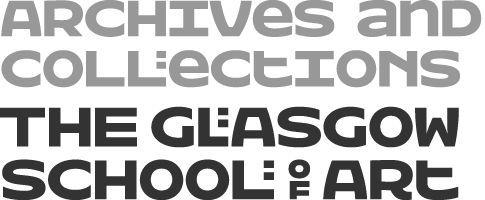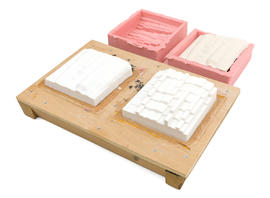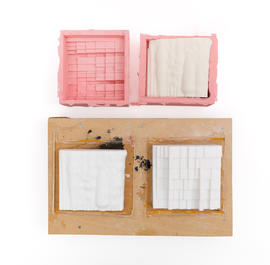Key Information
Reference code
Title
Date(s)
- May 2021-Aug 2021 (Creation)
Level of description
Item
Extent
2 parts
Content and Structure
Scope and content
Silicone moulds used in the prototyping process of mycelium tiles for use in the domestic interior. Created during Stage 3 of Master of Design in Interior Design. from Stage 3 of Master of Design in Interior Design project titled "Digital Design Craft Fabrication".
Project Synopsis: Recognising the increasing uptake of domestic craft activities seen during the COVID pandemic lockdowns, and the need driven by climate change to reconsider the materials we use and our relationships to the objects we surround ourselves with, this project proposes a series of interior objects to be crafted in and for the domestic environment, using waste material and other environmentally responsible materials.
Craft within two contrasting areas of Scotland (Glasgow and Argyll) formed the basis for the project research, with interviews and observation of craft practitioners working in these areas conducted. Both analogue and digital methods were employed to process, manipulate and experiment with the data collected, and through this, new interior objects of domestic craft have been proposed. The forms of the proposed objects speak directly of the processes through which they have developed, highlighting the wider environmental connections of the objects.
Hand crafting objects for your own domestic environment results in objects valued on many levels. From valuing simply for the enjoyment of making or the ability to create something useful, to valuing these crafted objects’ ability to store memories or to express self-identity through their creation and display. In creating interior objects which are highly valued, their future responsible use is secured.
Artefact description: Silicon moulds taken from 3D Printed ‘tile’ which is an example of forms created through extraction and manipulation of data from a soundscape of furniture designer/maker Martin Campbell working in his workshop in the Southside of Glasgow. Scripts written within the visual scripting language Grasshopper were used with a 2D visual representation (spectral frequency image) of the furniture making soundscape as an input to the scripts. This input data was then used to drive the creation of 3D forms which were 3D printed.
The 3D prints are fixed to a plywood, pine and cement base (a leftover material exploration from a previous project) to allow silicone moulds to be taken from the 3D prints. The moulds were used during the project to create a mycelium tile grown on waste wood shavings taken from Martin Campbell’s workshop. This prototype is recorded within the digital project journal, but unfortunately decayed quickly. A jesmonite tile taken from one of the moulds is included as a physical artefact (NMC/2000C).
The mycelium tile was proposed for use as an internal window shuttering system. Mycelium, which is the root system of fungus, is currently a popular bio-material being explored within the design and construction industries as an environmentally responsible alternative to many existing materials such as leather. The mycelium can be grown on waste materials such as wood shavings, or as was also suggested in this project, domestic food waste such as coffee grounds or vegetable peelings. The mycelium can be grown in moulds, with the material baked once removed from the mould to stop further growth.
Appraisal, destruction and scheduling
Accruals
System of arrangement
General Information
Name of creator
Biographical history
David's interests surround environmentally responsible materials and methods of production, the combination of digital and craft methodologies, the democratisation of design, and the importance of interior design to the creation and expression of self-identity.
David enjoys finding and exploring connections between interior design and other subjects, taking a less serious, irreverent approach, using surreal narratives and humour to investigate these connections. He uses experimentation as a method of learning, employing both analogue and digital methods to investigate materials, forms and functions. He wishes to achieve designs which are fun, engaging and environmentally responsible.
Originally graduating from The Glasgow School of Art with an undergraduate MEng in Product Design Engineering, David then worked in design for several years in Glasgow, Leipzig and Rotterdam. In 2011 he co-founded Glasgow-based design community Analogue Social, assisting in the organising of design events across Scotland. He followed an interest in materials, working for three years with a sustainable timber supplier in the Highlands. In 2020 David returned to The Glasgow School of Art, attending the MDes Interior Design programme, passing with distinction and receiving the Chairman's Medal for top postgraduate student from the School of Design.
Archival history
Custodial history
Donated by David Ross, Mar 2022.
Physical Description and Conditions of Use
Conditions governing access
Conditions governing reproduction
Language of material
Script of material
Language and script notes
Physical Description
Silicone.
Dimensions: 150 x 165 x 60 mm (each).
Finding aids
Related Material
Existence and location of originals
Existence and location of copies
Related materials
Notes area
Alternative identifier(s)
Keywords/Tags
Place access points
People and Organisations
Genre access points
Status
Level of detail
Processing information
Catalogued by Michelle Kaye, Collections Lead, Oct 2024.
Language(s)
- English



